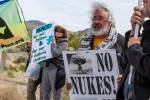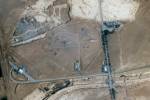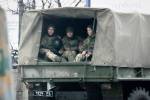Report: Nuclear testing remnants remain radioactive
Radioactive remnants from decades of nuclear bomb tests remain mostly in underground detonation sites at the Nevada National Security Site.
That was the upshot of the annual environmental monitoring report presented Wednesday night by Department of Energy staff and contractors to a citizens panel known as the Nevada Site Specific Advisory Board.
“What we attempted to do is a better job of putting groundwater monitoring into one section and make it more presentable to the public,” said Kathryn Knapp, a health physicist and DOE’s program manager for the annual environmental report.
Knapp and other scientists discussed the 270-page monitoring report outside the meeting at the National Atomic Testing Museum. They said it will be a very long time before tritium, the primary isotope they are tracking, travels through groundwater layers and reaches any off-site water supply wells. By then, tritium will have decayed to levels considered well within the safe drinking water standard.
Tritium, a radioactive form of hydrogen, occurs naturally in air and water, and is a first indicator of nuclear testing contamination. It is much lighter and migrates faster in the environment than plutonium or uranium particles.
“We’re still sampling for all those other long-lived radionuclides. We’re not seeing anything though,” National Nuclear Security Administration spokesman Darwin Morgan said Thursday. “It’s not anything we’re ignoring.”
Models for one area of concern, Frenchman Flat, show radioactive contaminants traveling so slowly in groundwater that “tritium will be gone” before it could reach any wells in Amargosa Valley, said Department of Energy geologist Bill Wilborn.
“The velocity in that part of the basin is so slow, a meter per year or so or a kilometer in 1,000 years,” that tritium with a half-life of 12.3 years will have decayed to safe levels, he said. A half-life is the time it takes for the radioactivity of a substance to decay to half of its initial value.
Wilborn said Frenchman Flat “is probably four or five kilometers from Mercury,” the government town at the test site, “and it’s even farther to community wells in Amargosa Valley.”
The report covers data from 84 monitoring wells both on and off the Rhode Island-size site, formerly known as the Nevada Test Site, 65 miles northwest of Las Vegas. The network is sampled to detect radioactive contamination from 828 below-ground nuclear tests that government scientists conducted until full-scale nuclear tests were curtailed in 1992. Most of the early tests, 100 in all, were conducted above ground, beginning with the first one at the Nevada site in 1951.
A 1963 treaty restricted nuclear tests to underground shafts or tunnel cavities. It was during this period in the early 1960s until testing ended in 1992 that hundreds of nuclear devices were set off at depths ranging from 90 to 4,800 feet below the surface. About one-third of those blasts occurred in, near or below the water table.
Tritium contamination in groundwater was first detected off-site in 2009 near where two nuclear tests — the 1968 Benham and 1975 Tybo tests — were conducted in Pahute Mesa in the site’s northwest corner.
Scientists have predicted it will take roughly 240 years for tritium-laced water from the Benham and Tybo tests to travel another 14 miles to the nearest public water source. By then it will have decayed to non-detectable levels.
Wilborn has said the contamination plume probably won’t reach Beatty, 120 miles northwest of Las Vegas. Instead, perhaps hundreds or 1,000 years, in his estimate, it will head between Beatty and Yucca Mountain, where the Department of Energy had planned to dispose of the nation’s spent nuclear fuel.
The Obama administration has starved the Yucca Mountain Project of funding but a federal court last year ordered the Nuclear Regulatory Commission staff to complete safety evaluations and proceed with licensing using what little funding remains.
Contact Keith Rogers at krogers@reviewjournal.com or 702-383-0308. Find him on Twitter: @KeithRogers2.























